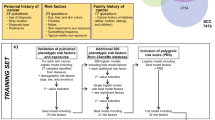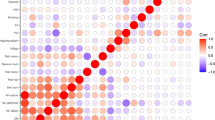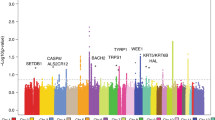Abstract
Genetic susceptibility to chemically induced skin cancer in mice is controlled by multiple unlinked genetic loci. Mus spretus mice have dominant resistance genes which confer resistance to interspecific F1 hybrids with susceptible Mus musculus strains. We have mapped three major resistance loci using a combination of Mapmaker/QTL analysis and multiple regression analysis to mouse chromosomes 5 and 7. At least two independent loci on chromosome 7 exert their effects primarily during benign tumour development and have very little influence on tumour progression. On the other hand, probably a single locus on chromosome 5 affects both early and late stages of malignancy. The results indicate that benign and malignant tumours are largely under independent genetic control.
This is a preview of subscription content, access via your institution
Access options
Subscribe to this journal
Receive 12 print issues and online access
$209.00 per year
only $17.42 per issue
Buy this article
- Purchase on Springer Link
- Instant access to full article PDF
Prices may be subject to local taxes which are calculated during checkout
Similar content being viewed by others
References
Demant, P. Genetic resolution of susceptibility to cancer—new perspectives. Sem. Cancer Biol. 3, 159–166 (1992).
Ponder, B.A. Inherited predisposition to cancer. Trends Genet. 6, 213–218 (1990).
Knudson, A.G. Antioncogenes and human cancer. Proc. natn. Acad. Sci.U.S.A 90, 10914–10921 (1993).
Peto, J. Predisposition to Cancer. in Cancer Incidence in Defined Populations (Banbury Report 4) (eds Caims, J., Lyon, J.L. & Skolnick, M.) 203–213 (Cold Spring Harbor Laboratory Press, Cold Spring Harbor, 1980).
Lander, E.S. & Schork, N.J. Genetic dissection of complex traits. Science 265, 2037–2047 (1994).
Mock, B.A., Krall, M.M. & Dosik, J.K. Genetic mapping of tumor susceptibility genes involved in mouse plasmacytomagenesis. Proc. natn. Acad. Sci. U.S.A. 99, 9499–9503 (1993).
Manenti, G. et al. Multiple loci affect genetic predisposition to hepatocarcinogenesis in mice. Genomics 23, 118–124 (1994).
Gariboldi, M. et al. Chromosome mapping of murine susceptibility loci to liver carcinogenesis. Cancer Res. 53, 209–211 (1994).
Bangrazi, C. et al. Genetics of chemical carcinogenesis. 1. Bidirectional selective breeding of susceptible and resistant lines of mice to two-stage skin carcinogenesis. Carcinogenesis 11, 1711–1719 (1990).
Gimenez-Conti, I.B. et al. Dissociation of sensitivities to tumor promotion and progression in outbred and inbred SENCAR mice. Cancer Res. 52, 3432–3435 (1992).
Drinkwater, N. & Ginsler, J.J. Genetic control of hepatocarcinogenesis in C57BL/6J and C3H/HeJ inbred mice. Carcinogenesis 7, 1701–1707 (1986).
Groot, P.C. et al. The recombinant congenic strains for analysis of multigenic traits: genetic composition. Res. Comm. 2826–2835 (1992).
Love, J.M., Knight, A.M., McAleer, M.A. & Todd, J.A. Towards construction of a high resolution map of the mouse genome using PCR-analysed microsatellites. Nucl. Acids Res. 18, 4123–4130 (1990).
Cornall, R.J., Aitman, T.J., Hearne, C.M. & Todd, J.A. The generation of a library of PCR-analyzed microsatellite variants for genetic mapping of the mouse genome. Genomics 10, 874–881 (1991).
Todd, J.A. et al. Genetic analysis of autoimmune type 1 diabetes mellitus in mice. Nature 351, 542–547 (1991).
Dietrich, W. et al. A genetic map of the mouse suitable for typing intraspecif ic crosses. Genetics 131, 423–447 (1992).
Ghosh, S. et al. Polygenic control of autoimmune diabetes in nonobese diabetic mice. Nature Genet. 4, 404–409 (1993).
Burns, P.A. et al. Loss of heterozygosity and mutational alterations of the p53 gene in skin tumors of interspecific hybrid mice. Oncogene 6, 2363–2369 (1991).
Hennings, H., Shores, R., Mitchell, P., Spangler, E.F. & Yuspa, S.H. Induction of papillomas with a high probability of conversion to malignancy. Carcinogenesis 6, 1607–1610 (1985).
Lander, E. et al. MAPMAKER: An interactive computer package for conducting primary genetic linkage maps of experimental and natural populations. Genomics 1, 174–181 (1987).
Paterson, A. et al. Resolution of quantitative traits into mendelian factors using a complete RFLP linkage map. Nature 335, 721–726 (1988).
Zeng, Z. Theoretical basis for separation of multiple linked gene effects in mapping quantitative trait loci. Proc. natn. Acad. Sci. U.S.A. 90, 10972–10973 (1993).
Bonney, G.E. Regressive logistic models for familial disease and other binary traits. Biometrics 42, 611–625 (1986).
Naito, M., Chenicek, K.J., Naito, Y. & DiGiovanni, J. Susceptibility to phorbol ester skin tumor promotion in (C57BL/6 × DBA/2) F1 mice is inherited as an incomplete dominant trait: evidence for multi-locus involvement. Cancer Research 15, 639–645 (1991).
Hearne, C.M. et al. Additional microsatellite markers for mouse genome mapping. Mammal. Gen. 1, 273–282 (1991).
Yuspa, S.H. The pathogenesis of squamous cell cancer: lessons learned from studies of skin carcinogenesis. Cancer Res. 54, 1178–1189 (1994).
Fischer, S.M. et al. Characterization of an inbred strain of the SENCAR mouse that is highly sensitive to phorbol esters. Carcinogenesis 8, 421–424 (1987).
Kemp, C.J., Burns, P.A., Brown, K., Nagase, H. & Balmain, A. Transgenic approaches to the analysis of ras and p53 function in multistage carcinogenesis. in Cold Spring Harbour Symposia on Quantitative Biology. Molecular Genetics of Cancer (Cold Spring Harbor Laboratory Press, Cold Spring Harbor, in the press).
Balmain, A. et al. Functional loss of tumour suppressor genes in multistage chemical c\arcinogenesis. in Multistage Carcinogenesis (eds Harris, C.C. et al.) 97–108 (Japan Sci.Soc.Press, Tokyo/CRC Press, Boca Raton, 1992).
Quintanilla, M., Brown, K., Ramsden, M. & Balmain, A. Carcinogen-specific mutation and amplification of Ha-ras during mouse skin carcinogenesis. Nature 322, 78–80 (1986).
Aldaz, C.M., Trono, D., Larcher, F., Slaga, T.J. & Conti, C.J. Sequential trisomization of chromosomes 6 and 7 in mouse skin premalignant lesions. Mol. Carcinog. 2, 22–26 (1989).
Kemp, C.J., Fee, F. & Balmain, A. Allelotype analysis of mouse skin tumours using polymorphic microsatellites: sequencial genetic alterations on chromosomes 6, 7 and 11. Cancer Res. 53, 6022–6027 (1993).
Bremner, R. & Balmain, A. Genetic changes in skin tumour progression: correlation between presence of a mutant ras gene and loss of heterozygosity on mouse chromosome 7. Cell 61, 407–417 (1990).
Bianchi, A.B., Aldaz, C.M. & Conti, C.J. Non-random duplication of the chromosome bearing a mutated Ha-ras-1 allele in mouse skin tumours. Proc. natn. Acad. Sci. U.S.A. 87, 6902–6906 (1990).
Bremner, R., Kemp, C.J. & Balmain, A. Induction of different genetic changes by different classes of chemical carcinogens during progression of mouse skin tumours. Molec. Carcin. 11, 90–97 (1994).
Gariboldi, M. et al. A major susceptibility locus to murine lung carcinogenesis maps on chromosome 6. Nature Genet. 3, 132 (1993).
Rinchik, E.M. et al. Mouse chromosome 7. Mamm. Gen. 3, s104–s120 (1992).
Krontiris, T.G., Devlin, B., Karp, D.D., Robert, N.J. & Risch, N. An association between the risk of cancer and mutations in the Hras1 minisatelllte locus. New Engl. J. Med. 329, 517–523 (1993).
Ryan, J., Barker, P.E., Nesbitt, M.N. & Ruddle, F.H. KRAS2 as a genetic marker for lung tumor susceptibility in inbred mice. J. natn. Cancer Inst. 79, 1351–1356 (1987).
Chen, B., Johanson, L., Wiest, J.S., Anderson, M.W. & You, M. The second intron of the K-ras gene contains regulatory elements associated with mouse lung tumor susceptibility. Proc. natn. Acad. Sci. U.S.A. 91, 1589–1593 (1994).
Alarid, E.T. et al. Keratinocyte growth factor functions in epithelial induction during seminal vesicle development. Proc. natn. Acad. Sci. U.S.A. 91, 1074–1078 (1994).
Carter, B.S., Ewing, C.M. & Ward, S.W. Allelic loss of chromosomes 16q and 10q in human prostate cancer. Proc. natn. Acad. Sci. U.S.A. 87, 8771–8775 (1990).
Vassar, R., Hutton, M.E. & Fuchs, E. Transgenic overexpression of transforming growth factor alpha bypasses the need for c-Ha-ras mutations in mouse skin tumorigenesis. Molec. Cell Biol. 12, 4643–4653 (1992).
Cheng, C. et al. Epidermal growth factor receptor ligands regulate keratin 8 expression in keratinocytes, and transforming growth factor alpha mediates the induction of keratin 8 by the v-rasHa oncogene. Cell Growth Diff. 4, 317–327 (1993).
Lee, C.C., Kozak, C.A. & Yamada, K.M. Structure, genetic mapping, and expression of the mouse Hgf/scatterfactor gene. Cell Adhes. Communication 1, 101–111 (1993).
Weidner, K.M., Behrens, J., Vanderkerckhove, J. & Birchmeier, W. Scatter factor: molecular characteristics and effect on the invasiveness of epithelial cells. J. Cell Biol. 111, 2097–2108 (1990).
Author information
Authors and Affiliations
Rights and permissions
About this article
Cite this article
Nagase, H., Bryson, S., Cordell, H. et al. Distinct genetic loci control development of benign and malignant skin tumours in mice. Nat Genet 10, 424–429 (1995). https://doi.org/10.1038/ng0895-424
Received:
Accepted:
Issue Date:
DOI: https://doi.org/10.1038/ng0895-424
This article is cited by
-
The parathyroid hormone regulates skin tumour susceptibility in mice
Scientific Reports (2017)
-
Panx3 links body mass index and tumorigenesis in a genetically heterogeneous mouse model of carcinogen-induced cancer
Genome Medicine (2016)
-
Variants in an Hdac9 intronic enhancer plasmid impact Twist1 expression in vitro
Mammalian Genome (2016)
-
Milestones in Skin Carcinogenesis: The Biology of Multistage Carcinogenesis
Journal of Investigative Dermatology (2014)
-
Interactions between wild-type and mutant Ras genes in lung and skin carcinogenesis
Oncogene (2013)



